If the Google Chrome, Edge, Internet Explorer and Firefox started showing annoying Notification.promo pop-ups then most probably that your web-browser has been infected by the nasty unwanted software from the adware (sometimes named ‘ad-supported’ software) family. This ad-supported software alters the Microsoft Edge, Firefox, Google Chrome and Internet Explorer settings to show lots of undesired pop ups on all web-pages, including pages where previously you ads have never seen. These ads can be varied: pop-up windows, boxes, in-text ads, different sized banners and so on. What is more, the adware, that opens the Notification.promo popups, can cause your Internet connection to be slow or freeze your web-browser so that the interface is not updated anymore.

https://www.notification.promo/chrome3 …
The ‘ad supported’ software that responsible for internet browser redirect to the annoying Notification.promo web page, is the part of the software that is used as an online promotional tool. It is made with the sole purpose to open dozens of popup ads, and thus to promote the goods and services in an open web browser window. Moreover, the ad-supported software can substitute the legitimate ads on misleading or even banners that can offer to visit malicious sites. The reason is simple, many advertisers agree on any ways to attract users to their web-sites, so the developers of ad-supported software, often forcing users to click on an advertising link. For each click on a link, the makers of the ‘ad supported’ software receive income.
The malicious software from the ‘ad supported’ software family that changes the settings of browsers usually hijacks only the MS Edge, Google Chrome, Microsoft Internet Explorer and Mozilla Firefox. However, possible situations, when any other web-browsers will be affected too. The ‘ad supported’ software may change the Target property of a browser’s shortcut, so every time you launch the web browser, instead of your homepage, you will see the annoying Notification.promo web-site.
So, obviously, you need to get rid of the ‘ad supported’ software sooner. Use the free step-by-step instructions below. This guide will allow you clean your PC of adware and thereby delete the Notification.promo intrusive pop up ads.
How to remove Notification.promo popups
In the tutorial below, we’ll try to cover the MS Edge, Chrome, Firefox and IE and provide general help to remove Notification.promo redirect. You may find some minor differences in your MS Windows install. No matter, you should be okay if you follow the steps outlined below: delete all suspicious and unknown programs, reset web-browsers settings, fix web-browsers shortcuts, get rid of malicious scheduled tasks, use free malicious software removal utilities. Some of the steps will require you to reboot your machine or close this page. So, read this guidance carefully, then bookmark or print it for later reference.
To remove Notification.promo, follow the steps below:
- Get rid of Notification.promo redirect without any utilities
- Delete potentially unwanted programs using Microsoft Windows Control Panel
- Get rid of unwanted Scheduled Tasks
- Fix internet browser shortcuts, changed by adware
- Remove Notification.promo popups from Chrome
- Remove Notification.promo from Firefox by resetting browser settings
- Remove Notification.promo pop-up advertisements from Internet Explorer
- Scan your computer and get rid of Notification.promo pop-up advertisements with free utilities
- Use AdBlocker to stop Notification.promo and stay safe online
- How to Notification.promo redirect get installed onto PC system
- To sum up
Get rid of Notification.promo redirect without any utilities
The following instructions is a step-by-step guide, which will help you manually remove Notification.promo popup ads from the Internet Explorer, Firefox, Google Chrome and Microsoft Edge.
Delete potentially unwanted programs using Microsoft Windows Control Panel
Some of PUPs, adware and browser hijacker infections can be uninstalled using the Add/Remove programs tool that can be found in the Windows Control Panel. So, if you’re running any version of MS Windows and you have noticed an unwanted program, then first try to remove it through Add/Remove programs.
Make sure you have closed all web browsers and other applications. Press CTRL, ALT, DEL keys together to open the Microsoft Windows Task Manager.

Click on the “Processes” tab, look for something questionable that is the ad-supported software which reroutes your web browser to intrusive Notification.promo web page then right-click it and select “End Task” or “End Process” option. In many cases, malicious software masks itself to avoid detection by imitating legitimate Microsoft Windows processes. A process is particularly suspicious: it’s taking up a lot of memory (despite the fact that you closed all of your programs), its name is not familiar to you (if you are in doubt, you can always check the application by doing a search for its name in Google, Yahoo or Bing).
Next, uninstall any undesired and suspicious apps from your Control panel.
Windows 10, 8.1, 8
Now, click the Windows button, type “Control panel” in search and press Enter. Choose “Programs and Features”, then “Uninstall a program”.

Look around the entire list of programs installed on your system. Most probably, one of them is the ‘ad supported’ software which cause unwanted Notification.promo advertisements to appear. Select the dubious program or the program that name is not familiar to you and delete it.
Windows Vista, 7
From the “Start” menu in Microsoft Windows, select “Control Panel”. Under the “Programs” icon, choose “Uninstall a program”.

Choose the questionable or any unknown applications, then click “Uninstall/Change” button to remove this undesired application from your computer.
Windows XP
Click the “Start” button, select “Control Panel” option. Click on “Add/Remove Programs”.

Choose an unwanted application, then click “Change/Remove” button. Follow the prompts.
Get rid of unwanted Scheduled Tasks
Once installed, the adware can add a task in to the Windows Task Scheduler Library. Due to this, every time when you launch your personal computer, it will open Notification.promo annoying web site. So, you need to check the Task Scheduler Library and delete all harmful tasks that have been created by ‘ad-supported’ apps.
Press Windows and R keys on the keyboard at the same time. This opens a dialog box that titled as Run. In the text field, type “taskschd.msc” (without the quotes) and press OK. Task Scheduler window opens. In the left-hand side, press “Task Scheduler Library”, as displayed in the following example.

Task scheduler
In the middle part you will see a list of installed tasks. Please choose the first task, its properties will be show just below automatically. Next, press the Actions tab. Pay attention to that it launches on your PC. Found something like “explorer.exe http://site.address” or “chrome.exe http://site.address”, then get rid of this malicious task. If you are not sure that executes the task, check it through a search engine. If it’s a component of the ‘ad-supported’ program, then this task also should be removed.
Having defined the task that you want to remove, then press on it with the right mouse button and choose Delete as shown on the image below.

Delete a task
Repeat this step, if you have found a few tasks that have been created by unwanted applications. Once is finished, close the Task Scheduler window.
Fix internet browser shortcuts, changed by adware
Unfortunately, the adware that causes unwanted Notification.promo popup ads, can also hijack Windows shortcuts (mostly, your browsers shortcut files), so that the Notification.promo ad web-page will be displayed when you run the Mozilla Firefox, Chrome, MS Edge and IE or another web-browser.
Open the properties of the web browser shortcut. Right click on the shortcut of infected browser and choose the “Properties” option and it will open the properties of the shortcut file. Next, select the “Shortcut” tab and have a look at the Target field as on the image below.
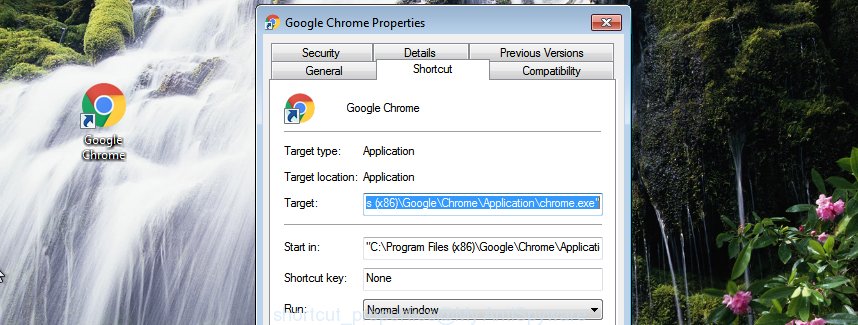
Normally, if the last word in the Target field is chrome.exe, iexplore.exe, firefox.exe. Be sure to pay attention to the extension, should be “exe”! All shortcut files that have been changed by adware that responsible for browser redirect to the intrusive Notification.promo page, usually point to .bat, .cmd or .url files instead of .exe like below

Another variant, an address has been added at the end of the line. In this case the Target field looks such as …Application\chrome.exe” http://site.address as displayed in the following example.

In order to fix the hijacked shortcut file, you need to insert right path to the Target field or remove an address (if it has been added at the end). You can use the following information to fix your shortcut files that have been altered by adware that causes tons of annoying Notification.promo pop-up ads.
| Google Chrome | C:\Program Files (x86)\Google\Chrome\Application\chrome.exe |
| C:\Program Files\Google\Chrome\Application\chrome.exe | |
| FF | C:\Program Files\Mozilla Firefox\firefox.exe |
| IE | C:\Program Files (x86)\Internet Explorer\iexplore.exe |
| C:\Program Files\Internet Explorer\iexplore.exe | |
| Opera | C:\Program Files (x86)\Opera\launcher.exe |
| C:\Program Files\Opera\launcher.exe |
Once is finished, click OK to save changes. Repeat the step for all web-browsers that are rerouted to the Notification.promo annoying web page.
Remove Notification.promo popups from Chrome
If your Google Chrome web browser is redirected to undesired Notification.promo web-page, it may be necessary to completely reset your browser application to its default settings.
Open the Chrome menu by clicking on the button in the form of three horizontal dotes (![]() ). It will display the drop-down menu. Choose More Tools, then press Extensions.
). It will display the drop-down menu. Choose More Tools, then press Extensions.
Carefully browse through the list of installed plugins. If the list has the extension labeled with “Installed by enterprise policy” or “Installed by your administrator”, then complete the following guidance: Remove Google Chrome extensions installed by enterprise policy otherwise, just go to the step below.
Open the Chrome main menu again, press to “Settings” option.

Scroll down to the bottom of the page and click on the “Advanced” link. Now scroll down until the Reset settings section is visible, like below and press the “Reset settings to their original defaults” button.

Confirm your action, press the “Reset” button.
Remove Notification.promo from Firefox by resetting browser settings
If your Mozilla Firefox internet browser is rerouted to Notification.promo without your permission or an unknown search provider shows results for your search, then it may be time to perform the internet browser reset.
Launch the Mozilla Firefox and click the menu button (it looks like three stacked lines) at the top right of the web-browser screen. Next, click the question-mark icon at the bottom of the drop-down menu. It will show the slide-out menu.

Select the “Troubleshooting information”. If you’re unable to access the Help menu, then type “about:support” in your address bar and press Enter. It bring up the “Troubleshooting Information” page as shown in the figure below.

Click the “Refresh Firefox” button at the top right of the Troubleshooting Information page. Select “Refresh Firefox” in the confirmation prompt. The Firefox will start a task to fix your problems that caused by the adware that responsible for web browser redirect to the annoying Notification.promo web-page. After, it’s finished, click the “Finish” button.
Remove Notification.promo pop-up advertisements from Internet Explorer
The Microsoft Internet Explorer reset is great if your internet browser is hijacked or you have unwanted addo-ons or toolbars on your web-browser, which installed by an malicious software.
First, launch the Microsoft Internet Explorer, click ![]() ) button. Next, click “Internet Options” as on the image below.
) button. Next, click “Internet Options” as on the image below.

In the “Internet Options” screen select the Advanced tab. Next, press Reset button. The Internet Explorer will display the Reset Internet Explorer settings prompt. Select the “Delete personal settings” check box and click Reset button.

You will now need to reboot your machine for the changes to take effect. It will remove ad-supported software that causes browsers to open undesired Notification.promo pop ups, disable malicious and ad-supported internet browser’s extensions and restore the Internet Explorer’s settings such as new tab page, homepage and default search engine to default state.
Scan your computer and get rid of Notification.promo pop-up advertisements with free utilities
Anti Malware programs differ from each other by many features such as performance, scheduled scans, automatic updates, virus signature database, technical support, compatibility with other antivirus programs and so on. We advise you run the following free apps: Zemana AntiMalware, MalwareBytes and AdwCleaner. Each of these programs has all of needed features, but most importantly, they can look for the adware and get rid of Notification.promo redirect from the IE, Edge, Chrome and Firefox.
Delete Notification.promo pop ups with Zemana Anti-malware
Zemana Anti-malware highly recommended, because it can detect security threats such ad supported software and adwares that most ‘classic’ antivirus programs fail to pick up on. Moreover, if you have any Notification.promo redirect removal problems which cannot be fixed by this utility automatically, then Zemana Anti-malware provides 24X7 online assistance from the highly experienced support staff.
Click the link below to download Zemana Free. Save it directly to your Microsoft Windows Desktop.
164814 downloads
Author: Zemana Ltd
Category: Security tools
Update: July 16, 2019
When downloading is finished, close all applications and windows on your computer. Double-click the install file called Zemana.AntiMalware.Setup. If the “User Account Control” dialog box pops up as displayed in the figure below, click the “Yes” button.

It will open the “Setup wizard” which will help you install Zemana on your machine. Follow the prompts and do not make any changes to default settings.

Once setup is complete successfully, Zemana Anti-Malware (ZAM) will automatically start and you can see its main screen like below.

Now click the “Scan” button for scanning your system for the ad supported software related to Notification.promo redirect. When a threat is detected, the count of the security threats will change accordingly. Wait until the the scanning is complete.

When Zemana Free has completed scanning, you will be opened the list of all found threats on your computer. When you’re ready, click “Next” button. The Zemana will get rid of ‘ad supported’ software that causes a huge number of intrusive Notification.promo pop up advertisements and add threats to the Quarantine. When disinfection is complete, you may be prompted to reboot the computer.
Scan and clean your PC of ad supported software with Malwarebytes
Get rid of Notification.promo redirect manually is difficult and often the ad-supported software is not completely removed. Therefore, we suggest you to use the Malwarebytes Free which are completely clean your personal computer. Moreover, the free application will allow you to remove malware, potentially unwanted apps, toolbars and browser hijacker infections that your computer can be infected too.
Installing the MalwareBytes Free is simple. First you’ll need to download MalwareBytes Anti-Malware on your Microsoft Windows Desktop from the following link.
327071 downloads
Author: Malwarebytes
Category: Security tools
Update: April 15, 2020
Once the download is complete, close all apps and windows on your machine. Double-click the set up file called mb3-setup. If the “User Account Control” dialog box pops up as on the image below, click the “Yes” button.
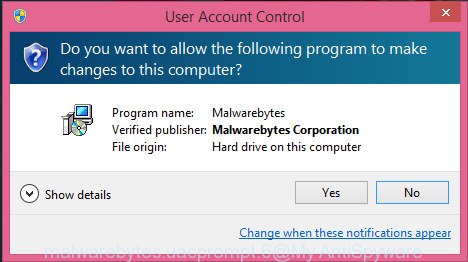
It will open the “Setup wizard” which will help you install MalwareBytes Anti Malware (MBAM) on your computer. Follow the prompts and do not make any changes to default settings.
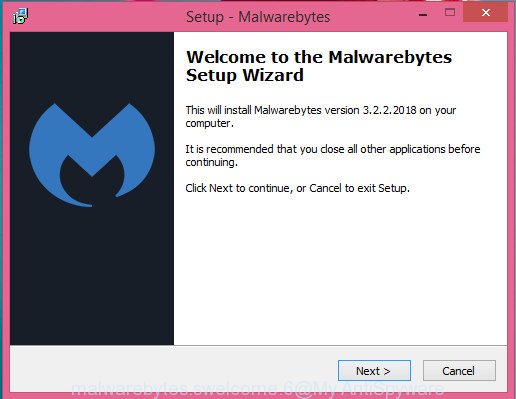
Once install is complete successfully, click Finish button. MalwareBytes Anti-Malware will automatically start and you can see its main screen as displayed below.
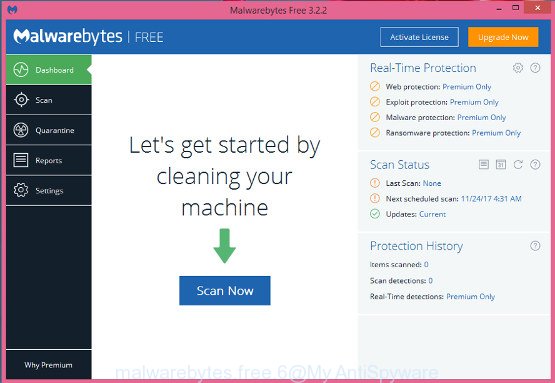
Now press the “Scan Now” button to perform a system scan with this tool for the adware responsible for redirecting your web browser to Notification.promo web-page. This procedure can take some time, so please be patient. When a threat is found, the number of the security threats will change accordingly. Wait until the the scanning is complete.
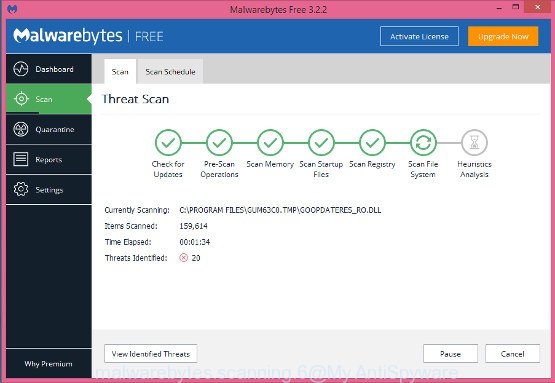
After the scan is done, MalwareBytes Free will show a list of all threats found by the scan. In order to get rid of all threats, simply click “Quarantine Selected” button. The MalwareBytes will remove adware which causes annoying Notification.promo pop-up advertisements and add threats to the Quarantine. After that process is done, you may be prompted to restart the computer.
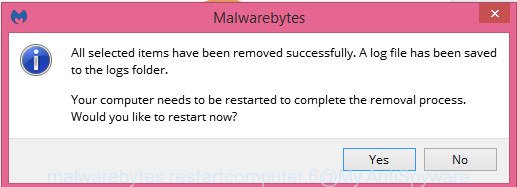
We recommend you look at the following video, which completely explains the procedure of using the MalwareBytes to remove adware, browser hijacker and other malicious software.
Double-check for potentially unwanted software with AdwCleaner
If MalwareBytes anti malware or Zemana Free cannot remove this adware, then we advises to run the AdwCleaner. AdwCleaner is a free removal tool for browser hijacker infections, potentially unwanted programs, toolbars and ad supported software that causes annoying Notification.promo advertisements.
Please go to the following link to download the latest version of AdwCleaner for MS Windows. Save it to your Desktop so that you can access the file easily.
225545 downloads
Version: 8.4.1
Author: Xplode, MalwareBytes
Category: Security tools
Update: October 5, 2024
Download and run AdwCleaner on your PC. Once started, click “Scan” button to start scanning your machine for the adware responsible for Notification.promo redirect. This task can take quite a while, so please be patient. While the tool is scanning, you can see number of objects and files has already scanned..
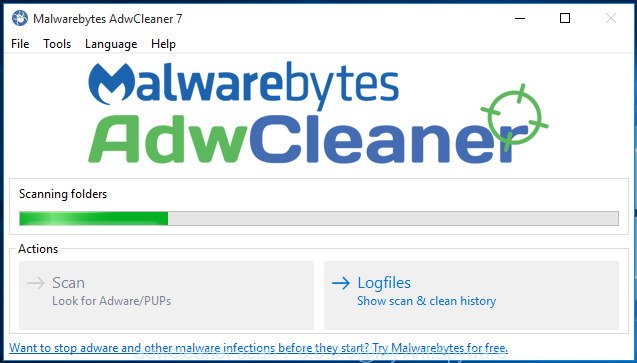
After the scan is finished, you’ll be opened the list of all detected threats on your computer. Once you’ve selected what you want to remove from your machine, click Clean button.
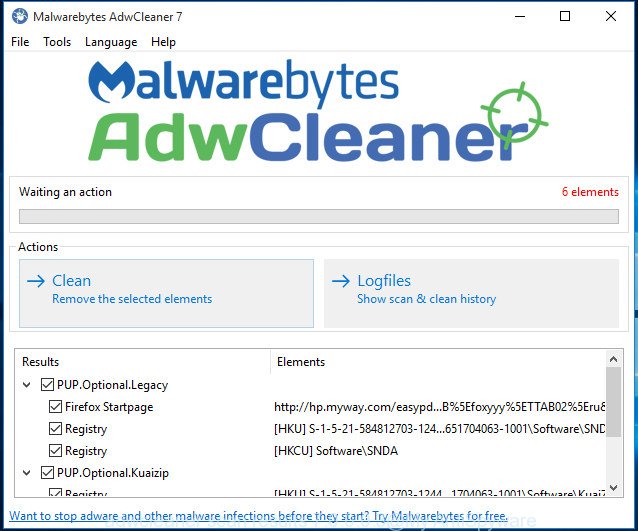
All-in-all, AdwCleaner is a fantastic free utility to clean your system from any undesired apps. The AdwCleaner is portable application that meaning, you do not need to install it to use it. AdwCleaner is compatible with all versions of MS Windows OS from Windows XP to Windows 10. Both 64-bit and 32-bit systems are supported.
Use AdBlocker to stop Notification.promo and stay safe online
We recommend to install an ad-blocking program that may stop Notification.promo and other unwanted pages. The ad-blocking tool like AdGuard is a program which basically removes advertising from the Net and blocks access to malicious web pages. Moreover, security experts says that using ad blocker applications is necessary to stay safe when surfing the World Wide Web.
Please go to the following link to download the latest version of AdGuard for Windows. Save it directly to your Microsoft Windows Desktop.
26843 downloads
Version: 6.4
Author: © Adguard
Category: Security tools
Update: November 15, 2018
Once the download is finished, start the downloaded file. You will see the “Setup Wizard” screen as shown below.

Follow the prompts. After the install is finished, you will see a window as shown in the following example.

You can click “Skip” to close the installation program and use the default settings, or click “Get Started” button to see an quick tutorial that will help you get to know AdGuard better.
In most cases, the default settings are enough and you do not need to change anything. Each time, when you run your PC system, AdGuard will launch automatically and stop popup advertisements, Notification.promo redirect, as well as other harmful or misleading pages. For an overview of all the features of the application, or to change its settings you can simply double-click on the AdGuard icon, that is located on your desktop.
How to Notification.promo redirect get installed onto PC system
Many adware are included in the freeware installer. Most often, a user have a chance to disable all included “offers”, but certain setup files are developed to confuse the average users, in order to trick them into installing the adware that responsible for the appearance of Notification.promo advertisements. Anyway, easier to prevent the ‘ad supported’ software rather than clean up your system after one. So, keep the web browser updated (turn on automatic updates), use a good antivirus applications, double check a free programs before you start it (do a google search, scan a downloaded file with VirusTotal), avoid harmful and unknown pages.
To sum up
Now your computer should be free of the ad supported software responsible for Notification.promo redirect. Remove AdwCleaner. We suggest that you keep AdGuard (to help you block unwanted pop up advertisements and intrusive harmful web-pages) and Zemana AntiMalware (to periodically scan your machine for new ad-supported softwares and other malware). Probably you are running an older version of Java or Adobe Flash Player. This can be a security risk, so download and install the latest version right now.
If you are still having problems while trying to remove Notification.promo popup ads from the Google Chrome, Firefox, Microsoft Internet Explorer and Edge, then ask for help in our Spyware/Malware removal forum.


















